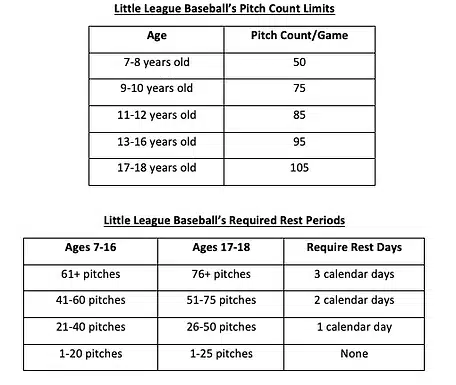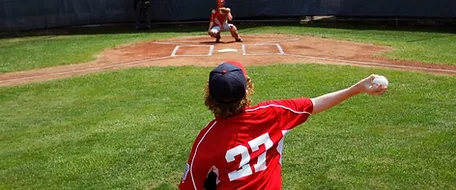Spring has sprung and everyone is biting at the bit to get back out of their houses (especially this year as COVID has forced many of us to remain home.
But no one wants to get out of the house more than the baseball and softball player in your life. Spring screams BASEBALL!!!

The problem with this year is that, due to COVID, many of the indoor practice facilities are not as readily available. Schools aren’t loaning out their gyms to Little Leagues, some of the private indoor facilities that have been available for rent in recent years (let alone had spring training lessons for kids) have closed, and the extra snow has even slowed the prospect of playing catch with Dad. The players are entering a season unprepared for the grind that is the baseball/softball season.
To add to that, there were many kids (and adult players) who missed their entire season last spring and weren’t able to make it up in the fall. So, these arms are as rusty as any have ever been.
So…Rusty arms PLUS limited access to training facilities PLUS anxious kids who are out to prove that they can still succeed in this amazing game LEADS TO ARM INJURIES!
This year, we need to be concerned about ALL the arms, not just the pitchers!
The concern for shoulder and elbow injuries including Little League Shoulder, Shoulder impingement, Labral Tears, Rotator Cuff Tears, Little League Elbow, and “the Dreaded” UCL tear (aka the Tommy John injury) are at an all time high among Surgeons and PTs.
BUT…These injuries can be prevented. It will take a team approach to slow this epidemic.
It starts now!
Throwers must work their way into the season, not unlike the Major Leaguers who come into Spring Training in shape and still only play half games and pitchers only pitch 2 inning max. At this point in the year, playing catch daily isn’t even recommended for your Little Leaguer or (even) High Schooler.
We should all start our throwers on an exercise program to make sure they are physically ready for the season. There are various exercise and training programs that are being used to increase velocity, but at this point we must limit the “velocity and volume” of throwers who are just getting back into training as these 2 issues are the major cause of injury in throwers. I recommend a well-rounded exercise program including core strengthening, leg strengthening, and the “Thrower’s 10”

(http://www.andrewsortho.org/docs/ThrowersTenExerciseProgram.pdf) program. As well as, taking the time to go for a mechanical analysis by a qualified professional.
Here are some MORE tips to keep your kids in the game and healthy:
- Warm up properly by stretching, running and “playing catch”
- Play other positions than just pitcher
- Adhere to Little League Pitching guidelines. (see the tables below)
- Avoid pitching on multiple teams (but if your kid does play on multiple teams, keep a journal of pitches and innings to coordinate between both teams)
- Don’t pitch on consecutive days
- NEVER use a radar gun
- Don’t play year round
- Develop skills and pitches that are age (and developmentally) appropriate. Master the fastball and changeup before even considering breaking pitches.
- COMMUNICATE regularly with your child on how his/her arm is feeling and if there is pain
- NEVER pitch through arm pain
- Emphasize control, accuracy and (most importantly) GOOD MECHANICS.
- Speak with a healthcare professional or Athletic Trainer if you have concerns about injuries or prevention strategies
- See a Specialist in Shoulder and Elbow injuries in children sooner than later if your pitcher is complaining of pain. It is better to rule out an injury than to make it worse. Making it worse can lead to worsening injuries and longer periods not playing or worse.
Following these recommendations can decrease the risk of throwing injuries, but there are more things that you can do to keep your child healthy.
Once the throwers are fully trained and ready to go, you still need to follow the pitch count and rest recommendations for your child’s age. See the below tables:


Remember, these are only guidelines, if your child complains of pain with throwing they need an evaluation, maybe some imaging and probably some treatment and rest. Talk to your child about the injury risks and all the steps that can be taken to combat these serious injuries and we can slow this epidemic and your child will not be part of these statistics.
If we all take the appropriate steps, we can stop this epidemic of throwing injuries one thrower at a time. The best way to stop an epidemic is to agree to not be part of it! So, make sure the thrower in your life starts training off slow, performs the exercises needed to get the arm ready, and listens to their body!
If you DO need some help with a throwing injury/pain, we are offering a FREE Consultation to all throwers to determine if the pain is something that needs rest OR SOMETHING MORE! Click the Link to below to see if you qualify for this FREE visit.
Click Here to Request Your Free Consultation
OR, if you want a more comprehensive analysis of your Throwing motion and Injury Risk, click the link below for more information on our Comprehensive Throwing Analysis.
Click Here to Make Sure Your Throwing Motion Won’t Hurt You
Some of you may not need the throwing consultation now, but just want to stay informed. For you, we have a Sport Injuries Prevention and Treatment book that we self-published. Click below to Download it, and keep it with you in case any injuries come up…it has great information of what to do to get back on the field quickly and stay injury-free.
Give me the Sports Injuries Book!

Whether you choose to take me up on any of these, I wish you a great and injury-free Baseball Season and hope to see you out on the field!

